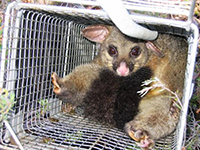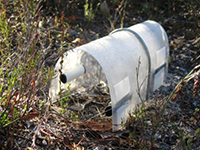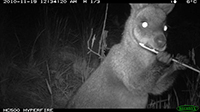Flora & fauna surveys - what & why?
- Flora & fauna surveys - Humula, Kyeamba, Junee.
- What is a flora & fauna survey?
- Why are flora and fauna surveys important?
Flora and fauna surveys in the Humula, Kyeamba and Junee area
Alison Elvin, Natural Capital and Dr Fiona Christie, University of Melbourne will be conducting 24 flora and fauna surveys in the Humula, Kyeamba and Junee areas in September this year. The aim of these surveys is to provide cross-property project landholders with a base-line of flora and fauna species that currently exists within our native vegetation remnants, and provide information to landholders on how to encourage greater diversity across their property and beyond their fence lines.
What is a flora and fauna survey?
A survey of any kind, in its most simple sense, is a list of things we see. Most of us probably drove our parents mad on those long road trips, enthusiastically reporting every time we happened to see our particular object of interest, whether it be a specific animal species (horses in our case!) or a car of a particular colour. Whatever your object of interest, the outcome is a list of observations over a particular area or time period.
A flora or fauna survey is no different; it is simply a list of plants and animals (usually vertebrates such as mammals, birds, reptiles and amphibians) which are observed in a given area. Broadly speaking, the purposes of flora and fauna surveys are generally to document “biodiversity” – the number of different species observed.
The presence of a species in a particular area can be detected in a number of different ways. Some commonly used approaches include:
- direct observations – sighting or hearing a call
- indirect observations – scats (poo)/hair/tracks
- stag watching
- spotlighting
- live trapping
- camera trapping
While knowing what species are present in an area is interesting in itself, flora and fauna surveys can also tell us much more. For example, the presence of parrots may indicate the presence of tree hollows. Hollows are typically found in older trees so this tells us something about not only that parrots may live there, but also the area itself. This is turn can help us consider whether other hollow dependent species or species which require older trees, may be present as well. Therefore, ecological knowledge of each species (i.e. where they shelter, what they feed on) can provide vital information beyond a measure of biodiversity, including the potential presence of other species, characteristics of the habitat, habitat quality and ecosystem resilience.
The type of information that flora and fauna surveys provide, will depend on a number of factors, with the most important being an understanding of why the survey is desired or required in the first place. Some of the more common aims or reasons as to why a flora and fauna survey is conducted are:
- to monitor changes in biodiversity over time
- to determine the presence of rare or threatened species
- to determine the presence of pest plant and animals
- to investigate the impact or potential impact of planned developments/operations
- to inform management programs
 Figure 1: Common Brushtail possum (Trichosurus vulpecula)caught in a baited cage trap. Photo: Amanda Ashton
Figure 1: Common Brushtail possum (Trichosurus vulpecula)caught in a baited cage trap. Photo: Amanda AshtonUnderstanding the aim of the survey will help determine what components of biodiversity will be surveyed and what type of information is collected (e.g. presence of species or abundance, or both).
Typically, birds and plants have been the focus of surveys, with relatively low costs (time and money) associated with the collection of these data compared to the traditionally time-consuming live trapping methods for mammals (Figure 1). As plants are generally stationary and many birds are day active and obvious, surveying these groups is generally easier than nocturnal mammals (Figure 2).
 Figure 2: Homemade “Hair tunnel” trap. Plastic sheet with sticky pads on internal walls, and bait suspended from centre. As animal approaches bait it brushes past the sticky pads leaving hair samples which can later be identified. Photo: Amanda Ashton
Figure 2: Homemade “Hair tunnel” trap. Plastic sheet with sticky pads on internal walls, and bait suspended from centre. As animal approaches bait it brushes past the sticky pads leaving hair samples which can later be identified. Photo: Amanda Ashton
In recent years however, the development of new technologies has significantly increased the capacity to include mammal surveys more regularly as part of fauna surveys. Remote wildlife cameras, or surveillance cameras, are one tool which is proving invaluable in the surveying of mammals. These infra-red cameras are simply set-up in a location of interest and focused on bait and left undisturbed for a number of days.
 Figure 3: “Wallaby playing a flute” - Black Wallaby or Swamp Wallaby (Wallabia bicolour) nibbling one of our dropped pencils! Information on the photograph includes date, time and temperature, data which can be used to investigate behaviour. Photograph taken by infrared wildlife camera.
Figure 3: “Wallaby playing a flute” - Black Wallaby or Swamp Wallaby (Wallabia bicolour) nibbling one of our dropped pencils! Information on the photograph includes date, time and temperature, data which can be used to investigate behaviour. Photograph taken by infrared wildlife camera.The camera takes photographs of any animal which comes to investigate the bait. Two types of bait are generally used (at different times), one to attract herbivorous or omnivorous species (e.g. rodents, marsupial mice, bandicoots, potoroos) and one to attract carnivores (e.g. Tasmanian Devils, quolls, cats, foxes). The camera can then be collected, all photos downloaded to a computer and species identified (e.g. Figure 3). These cameras can not only provide information on the presence of a species but also on how they behave (Figure 3). They also definitely beat having to wash hundreds of dirty traps each day in which a rat has spent the night, I can assure you!
Why are flora and fauna surveys important?
Flora and fauna surveys can be a powerful tool to inform management strategies relating to reserve design, fire management, threatened species conservation and restoration works. Surveys can identify species of conservation concern, or declines or increases in species in monitoring situations (whether they are rare or threatened or pest species), which can stimulate management interventions to counteract potentially adverse outcomes.
In Australia, many species have become extinct or have had their geographic range significantly reduced over the last 200 years. Without some knowledge of the presence of species we are often not aware that species may be at risk, or already in decline, until they are gone. Through the information provided by flora and fauna surveys we can gain a better understanding of the ecology of species and the environments in which they live. This understanding is vital to the long-term sustainable management of our environment and the biodiversity it supports. Monitoring communities, through surveys over time, can help predict how and why changes can occur.
Findings from flora and fauna surveys have the capacity to bring communities together, providing opportunities to enhance understanding of our complex ecosystems, their functioning and the inherent value of our native flora and fauna. In Australia we are lucky to have diverse and fascinating flora and fauna. You don’t have to be a scientist to do a flora or fauna survey, start with a list of birds you see in the garden, or plants you see in the native remnants on your property. Flora and fauna surveys are a great excuse to get outside and have some fun (Figure 4a & 4b). So get out there and take a look, you never know what you may find!

Figure 4: Kids setting up a carnivore bait station for camera trapping, then testing the automatic photo trigger.
By Dr Fiona Christie, University of Melbourne
